Published: 22 November 2019
Childlessness becoming more common among people with a lower level of education
According to Statistics Finland's statistics on the population structure, 18.8 per cent of women aged 45 to 49 resident in Finland in 2018 and speaking national languages were childless. The share of childless women among those with basic level qualifications was 22.5 per cent, 18.7 per cent for those with upper secondary level qualifications and 18.3 per cent for those with tertiary level qualifications. Over ten years, the share of childless women among those with upper secondary level qualifications has increased by 3.6 percentage points and by 3.0 percentage points among those with basic level qualifications.
Share of childless men and women aged 45 to 49 by level of education in 1987 to 2018, per cent
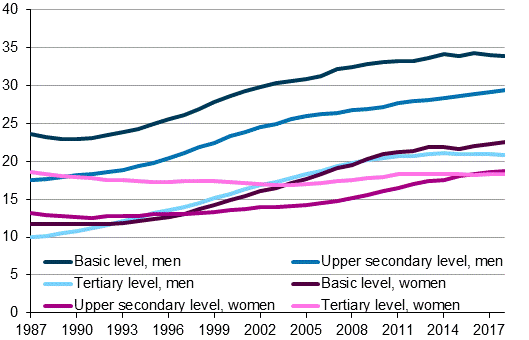
Childlessness also more common for men among those with a lower level of education
Among men aged 45 to 49 resident in Finland and speaking national languages 26.7 per cent were childless at the end of 2018. For men, the differences in the proportion of childless persons by level of education are clearly higher than for women. Among men with basic level qualifications one-third were childless, 29.4 per cent of those with upper secondary level qualifications and 20.8 per cent for those with tertiary level qualifications.
Increasing share of women aged 45 to 49 living in a childless partnership
More childless men and women aged 45 to 49 with basic level qualifications were living without a spouse in 2018 than in 1987.
Now, 43 per cent of childless women aged 45 to 49 with upper secondary level qualifications lived with a spouse, while in 1987 the share was 37 per cent.
The development for childless men and women aged 45 to 49 with tertiary level qualifications deviates from one another. An increasing number of men are living without a spouse while and increasing number of women are living with a spouse. While 70 per cent of childless women with tertiary level qualifications lived without a spouse in 1987, the share in 2018 was good one-half.
Childless men and women aged 45 to 49 by education and family status in 1987 and 2018
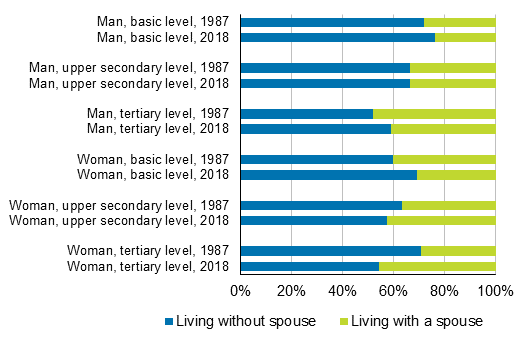
Share of childless persons highest in Uusimaa and town centres
At the end of 2018, the share of childless women aged 45 to 49 speaking national languages was highest in Uusimaa, 22 per cent. Ostrobothnia had the lowest share of 14 per cent. More than one-third of all childless women aged 45 to 49 speaking national languages lived in Uusimaa.
At the end of 2018, the share of childless women aged 45 to 49
speaking national languages was 40 per cent in inner urban areas.
Two-thirds of all childless women aged 45 to 49 speaking national
languages lived in core urban areas that consist of an inner and
outer urban area.
https://www.ymparisto.fi/en-US/Living_environment_and_planning/Community_structure/Information_about_the_community_structure/Urbanrural_classification
Sixty-one per cent of the population live in core urban areas
The degree of urbanisation has been discussed actively in recent years. Consolidation of municipalities into large regional centres has made it harder to follow the urbanisation development. As a result of administrative decisions, the population in the consolidated areas have become part of the urban population without the persons actually changing their place of residence. Conventional statistical grouping of municipalities does no longer in this changed situation provide an accurate picture of the development.
In total, 61 per cent of the Finnish population lived in core urban areas at the end of 2018. The core urban area consists of an inner and outer urban area. The outer boundary of the outer urban area refers to the outer edge of the built area with a street plan and describes the continuous built urban area.
Based on the conventional statistical grouping of municipalities, 72 per cent of the entire population was living in urban municipalities at the end of 2018.
In Uusimaa, four out of five live in core urban areas, in South Ostrobothnia only around one in four
Examined by region, there is great variation in the share of the population living in core urban areas. In total, 83 per cent of the population in the region of Uusimaa lived in core urban areas at the end of 2018. In Pirkanmaa, Päijät-Häme and Kymenlaakso, two-thirds of the population lived in core urban areas. In 10 regions out of 19, less than one-half of the population lived in core urban areas.
Share of population in Mainland Finland living in core urban areas by region in 1998 and 2018
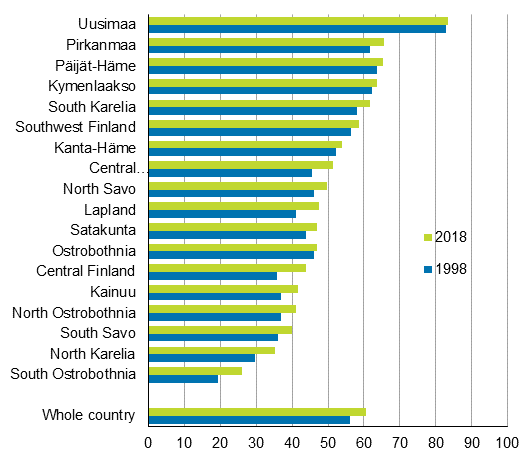
Examined by municipality, the share of the population living in core urban areas is highest in Greater Helsinki. Among the 20 largest municipalities, the share of the population living in core urban areas is lowest in Salo, 51.8 per cent, Kouvola, 56.8 per cent, and Mikkeli, 66.9 per cent. One-quarter of the population in Pori, Oulu and Kuopio live outside the core urban area. In the statistical grouping of municipalities and when examining the total number of population in the municipalities these persons living outside the core urban areas are included in the urban population which distorts the phenomenon.
Share of population living in core urban areas in the 20 largest municipalities in 1998 and 2018
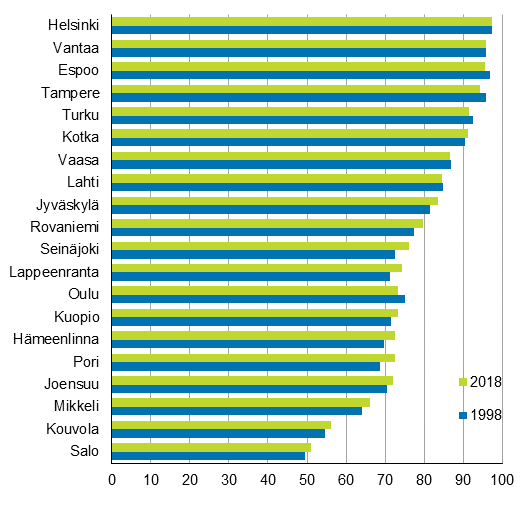
Population in core urban areas growing due to persons of foreign background
The share of those living in core urban areas of the population of the whole country has increased by five percentage points in 20 years. Fifty-five per cent of persons of Finnish background lived in urban core areas at the end of 1998 and 59 per cent at the end of 2018. Eighty-three per cent of persons of foreign background lived in urban core areas at the end of 1998 and 85 per cent at the end of 2018.
Over the past 20 years, the population in urban core areas has grown by 450,000 persons. Of this growth, 258,000 persons or more than one-half are of foreign background. Over the same period, the share of persons of foreign background in the population of core urban areas has increased from three per cent to ten per cent.
Migration gain of core urban areas by origin in 2006 to 2018
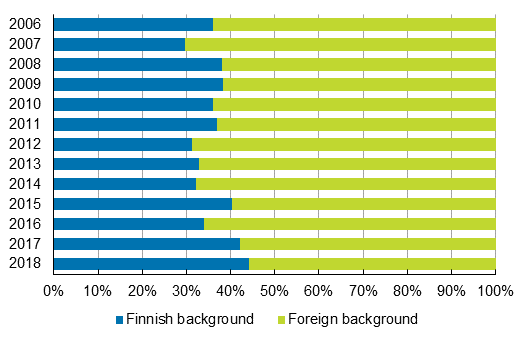
Source: Population Structure 2018, Statistics Finland
Inquiries: Markus Rapo 029 551 3238, info@stat.fi
Director in charge: Jari Tarkoma
Publication in pdf-format (389.8 kB)
- Tables
-
Tables in databases
Pick the data you need into tables, view the data as graphs, or download the data for your use.
Appendix tables
- Appendix table 1. Married women by duration and order of marriage 31.12.2018 (22.11.2019)
- Appendix table 2. Females aged 15 - 83 by number of live-born children 31.12.2018 (22.11.2019)
- Appendix table 3. Males aged 15 - 83 by number of live-born children 31.12.2018 (22.11.2019)
- Appendix table 4. Women by age, number of children and the proportion of birth 31.12.2018 (22.11.2019)
- Appendix table 5. Males by age and number of children 31.12.2018 (22.11.2019)
- Figures
- Quality descriptions
-
- Quality description: Population structure 2018 (22.11.2019)
Updated 22.11.2019
Official Statistics of Finland (OSF):
Population structure [e-publication].
ISSN=1797-5395. annual review 2018. Helsinki: Statistics Finland [referred: 23.12.2025].
Access method: http://stat.fi/til/vaerak/2018/01/vaerak_2018_01_2019-11-22_tie_001_en.html

